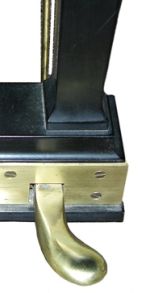 By some, it’s considered a mark of distinction to play J. S. Bach’s music on the modern piano using no pedal. Glenn Gould often did. Several of my students have aspired to. It seems like it must be harder to play that way, more pure, more noble. And the harpsichord has no such device for extending sound — so perhaps it’s more “authentic” to eschew the pedal in old music?
By some, it’s considered a mark of distinction to play J. S. Bach’s music on the modern piano using no pedal. Glenn Gould often did. Several of my students have aspired to. It seems like it must be harder to play that way, more pure, more noble. And the harpsichord has no such device for extending sound — so perhaps it’s more “authentic” to eschew the pedal in old music?
I always use the pedal. Perhaps judiciously or even undetectably — to the non-pianist. But always. It’s a bit of an obsession. I believe the piano’s right pedal (that raises the dampers and allows sounds to be held or overlapped) is integral to the operation of the instrument. Really good pedaling is rare. The “close-up” of the modern recording is revealing. Tiny intersections between notes in a musical line, or transition from one harmony to the next, are more audible than in a concert hall. Especially in quiet music, subtle pedaling really matters in recordings.
I played a concert in Luxembourg that was linked to performances by one of my students — who likes to play old music on the modern piano using no pedal. I thought as a sort of homage I would play the tricky last movement of a piano sonata by Haydn without any pedal. I have to admit it felt a bit risky, until I actually started to work on the piece that way. Then I learned something: it’s easier to play complicated fast piano music without the pedal!
The necessarily rapid changes of pedal in fast music introduce an added layer of syncopated physical activity that greatly increases the difficulty of the overall task. It’s patting your head and rubbing your tummy on a large scale. It’s “syncopated” in that the changes of pedal accomplished with the foot do not quite line up in time with the gestures being made by fingers and hand. The motor coordination required is much more complex than playing with the fingers alone.
The syncopated, overlapping binding of sound with the right pedal (that pianists now take for granted) may not have developed until the 1830s. Imagine slow movements of piano pieces by Mozart or Beethoven without the smooth connection of the foot… Typical pedaling in the middle 18th Century featured long sustained stretches of unchanging pedal — we see the evidence in Beethoven’s and Haydn’s markings.
As I practiced my unpedaled Haydn rendition, a difficult spot in the music that always challenged me was now easy. Aha, Gould was on to something!

Oh God. Pedal is sometimes a nightmare for me… before I knew any better I would insert it randomly into music whenever I felt like it. Then I learned the first movement of the Pathetique, and the opening bars are often played with pedal between each chord change (you probably know what I’m talking about) and my teacher was just shaking her head because I just was so uncoordinated that my sub par pedalling skills couldn’t handle it.
I ended up playing it without pedal. And I still struggle with pedal in said slow movements of Mozart or Beethoven.
Gould was a virtuoso whose technique was all in the service of whatever he thought would be best musically, and no-pedal playing sometimes fits the bill, certainly. But he was also a strong proponent of technical advances in musical instruments and sound recording, and he would not have eschewed the pedal for any reason but musicality. Ease of play would have been a laughably inadequate reason for it. Of course it’s easier to play without pedal: it’s one less task. Why not play the organ without pedal, too, while we’re at it?
Bruce Brubaker adds:
I’ll admit that at my organ playing debut — one afternoon in the Shed at Tanglewood — the other pianist who was my page turner obliged by playing the pedal part, while I took the keyboards.
It seems that we ought to be a bit less idealistic about Gould’s aspirations as undisputed as his genius may be. I believe that at least to a degree Gould believed that not using the pedal was rendering his performances more “authentic.”
But let us put Gould, Bach and harpsichords aside for a moment. When talking about piano music of Haydn, Mozart, Beethoven and Schubert in the context of instruments that were available to them, it would be more sonically “authentic” to indeed play everything WITH constantly changing pedal that the entry is describing. The release (or should be say the “death”) of sound on pianos of their time was much less abrupt than on modern instruments even if the actual sound was sustained for a shorter time. Thus, playing a note without any pedal on, say, an 1830 Troendlin is sonically very close to playing a note on a modern Steinway, pedaling it, and rather gently releasing the pedal. In other words, the quick, clean end to sound that is available to us on modern pianos (without the use pedal) is in fact hardly possible on older instruments. Given this, the only way to match the “imperfection” of release intrinsic to a fortepiano on a modern piano is to use pedal.